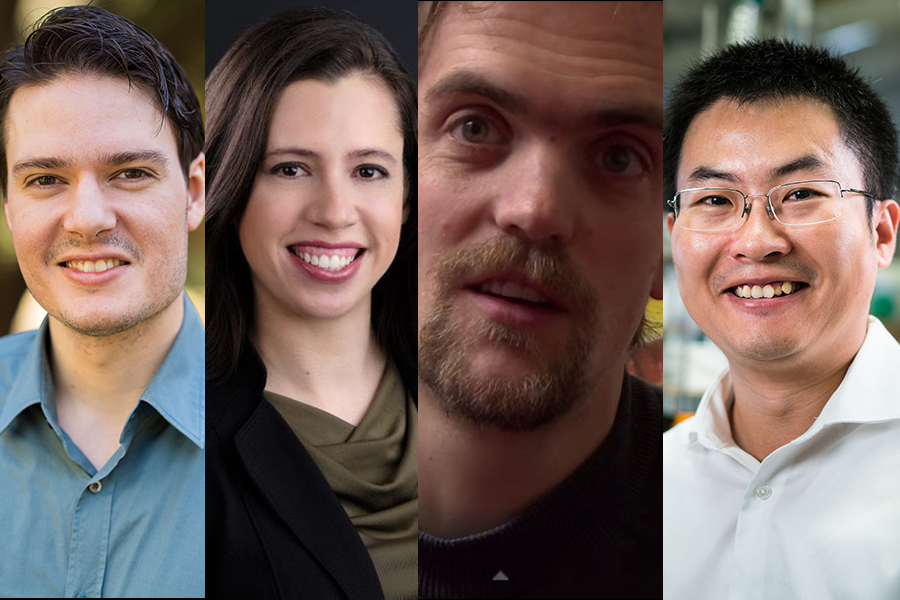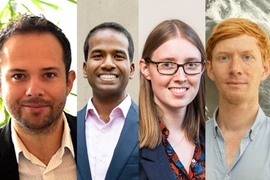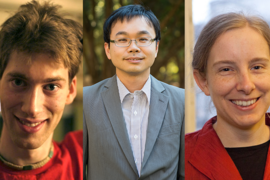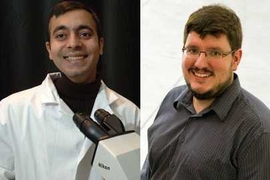The U.S. Department of Energy (DoE) recently announced the names of 83 scientists who have been selected for their 2021 Early Career Research Program. The list includes four faculty members from MIT: Riccardo Comin of the Department of Physics; Netta Engelhardt of the Department of Physics and Center for Theoretical Physics; Philip Harris of the Department of Physics and Laboratory for Nuclear Science; and Mingda Li of the Department of Nuclear Science and Engineering.
Each year, the DoE selects researchers for significant funding the "nation’s scientific workforce by providing support to exceptional researchers during crucial early career years, when many scientists do their most formative work."
Resonant coherent diffractive imaging of quantum solids
The quantum technologies of tomorrow –– more powerful computing, better navigation systems, and more precise imaging and magnetic sensing devices –– rely on understanding the properties of quantum materials. Quantum materials contain unique physical characteristics, and can lead to phenomena like superconductivity. Detecting and visualizing these materials at the nanoscale will enable scientists to understand and harness the properties of quantum materials.
Riccardo Comin, the Class of 1947 Career Development Assistant Professor of Physics, leads the Comin Photon Scattering Lab at MIT. The group uses high-energy electromagnetic waves, or X-rays, to observe how new collective states emerge at the nanoscale in quantum materials. This is a difficult feat, as the lenses in cameras and in the human eye do not work for X-rays as they do for visible light. Conventional microscopy techniques are not well-suited for visualizing these complex phenomena.
To overcome this technical limitation, the Comin group has worked on a “lensless” X-ray microscopy approach to image these electronic textures.
“These new imaging techniques are really fascinating and deeply challenge our traditional ways of performing X-ray microscopy,” Comin says. “We now rely on special algorithms that can perform computationally the task of image reconstruction that is normally taken care of by a lens.”
The support from the DoE Early Career Research program will be instrumental to the group’s work developing and applying these novel techniques to study the nanoscale organization of quantum materials of interest. Looking beyond the horizon of quantum materials, the availability of lensless X-ray imaging methods provides a new powerful tool set for the characterization of catalysts, batteries, data storage devices, soft matter, and biological systems.
Spacetime emergence from quantum gravity
Few phenomena in modern physics remain as mysterious as the black hole interior. Black holes seem to wreck the objects that fall into them, as well as information about what those objects once were. Yet according to basic principles of quantum mechanics (the study of subatomic particle behavior), knowing the current state of a given system should mean knowing everything about its past and future.
General relativity and quantum mechanics are two highly tested theories. When it comes to black holes, general relativity and quantum mechanics disagree on a fundamental point: whether information about the region behind the event horizon can escape and be decoded by an observer outside of the black hole. The clash between general relativity and quantum mechanics on this matter results in what is termed the “black hole information paradox.” In recent years, scientists have drawn numerous connections between gravity and quantum information.
Netta Engelhardt, the Biedenharn Career Development Assistant Professor of physics and member of the Center for Theoretical Physics, researches quantum gravity and the black hole information paradox.
“With a recent leap in our understanding of the black hole information paradox, the connection between gravity, quantum computational complexity, and black holes has newfound potential to shed light on some of the most foundational questions about quantum gravity, starting with ‘What really happens inside a black hole?’” Engelhardt says.
With support from the DoE award, her project aims to move toward resolving the black hole information paradox using some of the novel tools and insights at the intersection of the two theories.
Harnessing the Large Hadron Collider with new insights in real-time data processing and artificial intelligence
Particle accelerators help scientists learn more about the particles that comprise matter.
Nearly 17 miles in circumference, the Large Hadron Collider (LHC) at the European Center for Nuclear Research is the largest and most powerful particle accelerator in the world, producing valuable information for researchers.
Researchers have spent much time using LHC data to investigate novel particle interactions at the highest energies. But over the next two decades, they anticipate shifting their focus, directing their efforts toward precision measurements that target physics processes with small interaction strengths and extensive background rates.
As a result of these more detailed observations, physicists expect additional rare and hidden processes within the Standard Model (SM) of particle physics, and potentially beyond the SM, to emerge as more data mounts.
Philip Harris, assistant professor of physics and researcher in the Laboratory for Nuclear Science, is working on a physics program to measure those smaller, more inconspicuous processes. Specifically, with the support of DoE funding, his research aims to exploit a new measurement technique he created to identify light resonances that decay into quarks –– the particles that eventually combine to create subatomic particles.
“In conjunction with advanced artificial intelligence algorithms, this new technique can open up a wealth of unique measurements and searches,” Harris says. “The fully developed state-of-the-art system will empower new measurements of the Higgs boson, new searches for dark matter, and analyses of a multitude of unexplored scientific phenomena.”
Machine learning-augmented multimodal neutron scattering for emergent topological materials
Topological materials are a class of quantum materials whose electronic properties have robust protection against outside influences. This robustness enables a wide range of promising applications, such as next-generation electronics without energy loss, and error-tolerant quantum computers.
But it’s difficult to directly test materials for their topological properties. Rather, scientists usually use methods that measure manifestations of topology. One such method is neutron scattering, or neutron spectroscopy, a process used by scientists to assess materials.
Neutron scattering has particular advantages when it comes to evaluating topological quantum materials, but more information is needed to understand exactly how massive amounts of data gathered during neutron spectroscopy map onto topology.
The DoE Early Career Research Program Award will support Mingda Li, the Norman C. Rasmussen Assistant Professor of Nuclear Science and Engineering, in his machine-learning approach to analyzing high-dimensional neutron scattering spectra in quantum materials.
“The new approach will augment existing neutron scattering probes by measuring things that were not measurable before,” Li says. By doing so, “it will enable a broader discovery of hidden materials states that may have electronics applications, and identify topological solutions that can be used for computer memory.”









